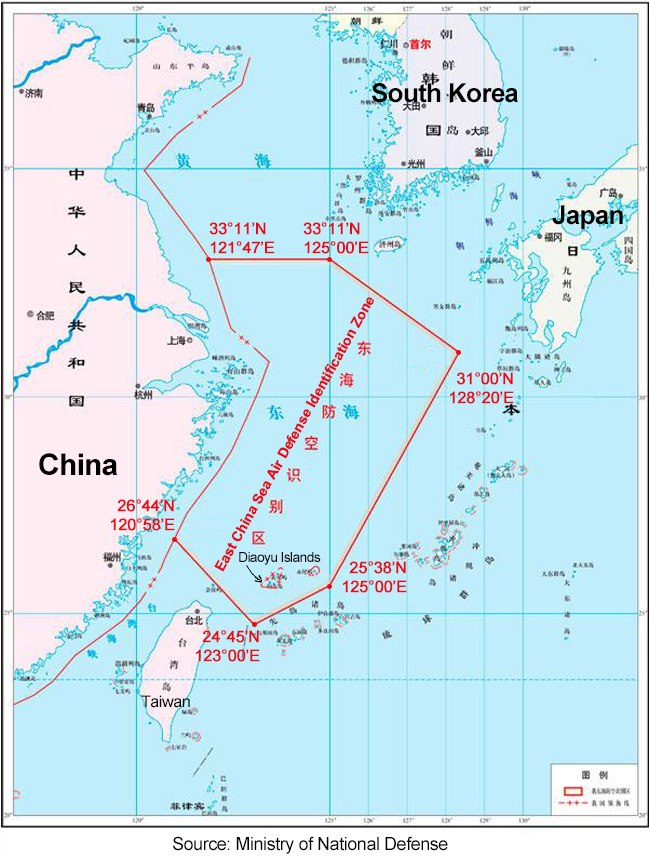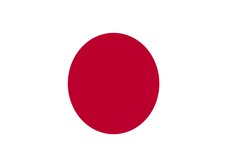HOME >>
China sets up 'air defense zone' over East China Sea
Source:Globaltimes.cn Published: 2013-11-24 16:59:00
| Latest News |
| Background |
| Japan's Air Defense Identification Zone: After Japan’s surrender in 1945, the US demarcated an identification zone off Japan’s coasts, but it was under the control of the US military in Japan. It was only until 1969 that the US transferred the management of the zone to Japan. After that, Japan expanded the zone westward twice, once in 1972, the other in 2010. Japan follows a warning sequence for unidentified aircraft: radar detection, emergency calls, fighter emergency launch, requiring forced landing, and bomb warning. Once its own aircraft, land, or vessels are attacked, a defense war will be launched. However, territorial disputes still exist, as the zone is not recognised by Japan’s neighbors, Russia and China. |
| Graphics |

Law of the People's Republic of China on National Defense (March 14, 1997)
Law of the People's Republic of China on Civil Aviation (October 30, 1995)
Basic Rules on Flight of the People's Republic of China (July 27, 2001)
| Intl reactions |
 |
US: US B-52 bombers flying into Chian Air Zone is a planned flight exercise In an interview with CCTV, the US Deputy National Security Advisor, Ben Rhodes says the two B-52 bombers flying into East China Sea defense air identification zone is a planned flight exercise. Statement on the East China Sea Air Defense Identification Zone The United States is deeply concerned about China's announcement that they've established an "East China Sea Air Defense Identification Zone." This unilateral action constitutes an attempt to change the status quo in the East China Sea. Escalatory action will only increase tensions in the region and create risks of an incident. Hagel issues Statement on East China Sea Air Defense Identification Zone |
 |
Japanese airlines to shun rules Japanese airlines Tuesday said they would not submit their plans to Chinese authorities for flying over China's newly established Air Defense Identification Zone (ADIZ) in the East China Sea, the Kyodo News reported. Japanese carriers adhere to China ADIZ despite govt opposition Japan's remarks on China's air defense identification zone "unacceptable": DM spokesman China creates new air defense zone in East China Sea amid dispute with Japan |
| Commentary |
Xinhua:
Air defense identification zone a strategic decision: experts
The establishment of the East China Sea Air Defense Identification Zone is a strategic decision in accordance with China's current national security situation, experts told Xinhua on Sunday.
"Setting up the air defense identification zone can effectively safeguard national sovereignty and security," said Zhang Junshe, a military expert, adding that the move conforms to the fundamental spirit and principle of international law.
"Various aircraft with high altitude and high-speed flying capabilities have been broadly used around the world with the development of aviation technology, and it's hard for China to identify an unidentified flying object and adopt countermeasures immediately," said Meng Xiangqing, a military expert.
The establishment of the zone can help set aside early warning time to ascertain an aircraft's purpose and attributes and adopt measures to protect air defense security, Meng said.
Commentary: US, Japan's logic on air zone ridiculous
Commentary: US, Japan wrong to blame China for air zone
China's air defense zone doesn't target specific country: expert
PLA Daily:
Some countries think because China takes the economy as its first priority, it will compromise on key issues and interests to maintain the peaceful development. That’s obviously a misconception. China will never trade in its core interests and impair national sovereignty and territorial integrity.
people.com.cn:
Yin Zhuo, a military expert from the Chinese Navy Advisory Committee for Informatization
“The Yangtze River Delta region is a very important economic development area and vital strategic objective for China. The economic contributions of the Yangtze River Delta region occupy a very large share of China’s total GDP. Therefore, maintaining security in the Yangtze River Delta region is a top priority in air defense.”
Taipei Times:
Li Fung, a Hong Kong-based Chinese military expert, said that China’s move can be regarded as an effort to bolster Beijing’s sovereignty claims over the islands.
Foreign media:
AP:
US expresses concern after China sets air defense zone over East China Sea
A rising economic and military power, China has become more assertive over its maritime claims. It has been in disputes with several neighboring countries over islands in the East and South China seas.
BBC:
China establishes 'air-defence zone' over East China Sea
BBC World Service East Asia editor Charles Scanlon says the confrontation over the small chain of uninhabited islands is made more intractable by conflicting claims for potentially rich energy resources on the sea bed.
But the issue has now become a nationalist touchstone in both countries, making it hard for either side to be seen to back down, he says.
Reuters:
US, Japan slam China's 'destabilizing' move on East China Sea airspace
Security experts echoed the concerns about an escalation, saying that if China were to enforce the air defense identification zone, a non-military Chinese aircraft's flying into it could lead to a military face-off between the two sides.
"If two fighter aircraft - one from their side and one from our side - meet in the air, that would create a precarious situation," said Narushige Michishita, director at Japan's National Graduate Institute for Policy Studies. "That's very dangerous."
Los Angeles Times:
China ups ante in conflict with Japan with new air defense ID zone
"I don’t know that this is specifically directed against Japan, so much as it is the Chinese feeling that every modern country should have an air defense identification zone," said Bonnie Glaser of the Washington-based Center for Strategic and International Studies.
"There are Japanese analysts who think tensions have eased a bit, but it has to do with the number of typhoons. I don’t think the Chinese are preparing to make any compromises," said Glaser.
| Related News |
Japan mulls combat vehicles near Diaoyu
Chinese coast guard patrols Diaoyu Islands
China urges joint efforts to maintain regional peace
Chinese plane flies near Diaoyu: report
China ‘observes’ US B-52s
B-52’s defiance no reason for nervousness
Web editor: wangnan1@globaltimes.com.cn
Posted in: Frontpage